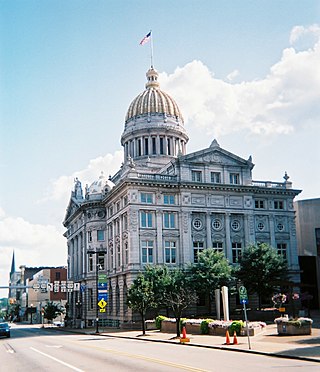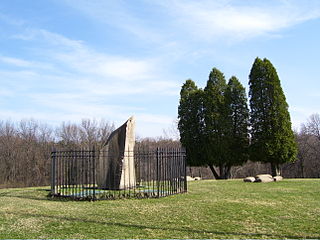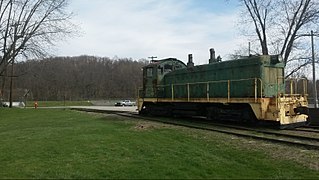
Westmoreland County is a county in the Commonwealth of Pennsylvania, United States. As of the 2020 census, the population was 364,663. The county seat is Greensburg and the most populous community is Hempfield Township. It is named after Westmorland, a historic county of England.

Monroeville is a home rule municipality in Allegheny County, Pennsylvania, United States. It is a suburb with mixed residential and commercial developments located about 10 miles (16 km) east of Pittsburgh. As of the 2020 census, Monroeville was home to 28,640 people.

North Versailles is a first class township in Allegheny County, Pennsylvania, United States. The population was 10,079 at the 2020 census. The township derives its name from the Palace of Versailles.

Plum is a borough in Allegheny County, Pennsylvania, United States. The population was 27,144 at the 2020 census. A suburb of the Pittsburgh metropolitan area, it is located northeast of the city in what is commonly referred to as the East Hills suburbs.

Murrysville is a home rule municipality in Westmoreland County, Pennsylvania, United States. The population was 21,006 at the 2020 census. It is part of the Pittsburgh metropolitan area.

Penn Township is a township in Westmoreland County, Pennsylvania, United States.

Slickville is a census-designated place (CDP) in Westmoreland County, Pennsylvania, United States. The population was 372 at the 2000 census.

Trafford is a borough in Allegheny and Westmoreland counties in the U.S. state of Pennsylvania. Located near Pittsburgh in western Pennsylvania, the borough lies primarily in Westmoreland County; only a small portion extends into Allegheny County. It was incorporated in 1904 from the northernmost corner of North Huntingdon Township, and was named by George Westinghouse for Trafford near Manchester, England. Westinghouse purchased the land in 1902, and the Trafford Foundry began operations on October 3, 1903. The population was 3,317 at the 2020 census. Of this, 3,113 were in Westmoreland County, and only 61 were in Allegheny County.

Wilkins Township is a township in Allegheny County, Pennsylvania, United States. The population was 6,357 at the 2010 census. It is served by Pennsylvania's 12th congressional district, the 43rd District of the Pennsylvania State Senate, and the 34th District of the Pennsylvania State House of Representatives.

The Great Allegheny Passage (GAP) is a 150-mile (240 km) rail trail between Pittsburgh, Pennsylvania and Cumberland, Maryland. Together with the C&O Canal towpath, the GAP is part of a 335 mi (539 km) route between Pittsburgh and Washington, D.C., that is popular with through hikers and cyclists.

Franklin Regional School District is a midsized, suburban public school district located in Murrysville, Pennsylvania, serving Murrysville and the neighboring communities of Delmont and Export. Franklin Regional School District encompasses approximately 38 square miles (98 km2). According to 2020 federal census data, it serves a resident population of 19,438 people. According to District officials, in school year 2021-22, Franklin Regional School District provided basic educational services to 3,555 pupils through the employment of 249 teachers, 152 full-time and part-time support personnel, and 19 administrators.

Transportation in Pittsburgh, Pennsylvania is different than in many other major American cities. A large metropolitan area that is surrounded by rivers and hills, Pittsburgh has an infrastructure system that has been built out over the years to include roads, tunnels, bridges, railroads, inclines, bike paths, and stairways; however, the hills and rivers still form many barriers to transportation within the city.

Pennsylvania Route 380, also known as J.F. Bonetto Memorial Highway and within the city of Pittsburgh Bigelow Boulevard, Baum Boulevard and Frankstown Road, is a 32.80 mi (52.8 km) long state highway in western portions of the U.S. state of Pennsylvania. The western terminus of the route is at Interstate 579 in downtown Pittsburgh near PPG Paints Arena. The eastern terminus is at Pennsylvania Route 286 in Bell Township, near the hamlet of Wakena.

Turtle Creek is a 21.1-mile-long (34.0 km) tributary of the Monongahela River that is located in Allegheny and Westmoreland counties in the U.S. state of Pennsylvania. Situated at its juncture with the Monongahela is Braddock, Pennsylvania, where the Battle of the Monongahela was fought in 1755.

Pennsylvania Route 130 (PA 130) is a 49-mile-long (79 km) state highway located in Allegheny and Westmoreland counties in Pennsylvania. The western terminus is at PA 8 in Pittsburgh, and the eastern terminus is at PA 381 near Kregar.

Pennsylvania Route 286 is a 69-mile-long (111 km), east–west state highway located in Allegheny, Westmoreland, Indiana, and Clearfield counties in Pennsylvania.

The Turtle Creek Industrial Railroad was a short line freight railroad that operated in western Pennsylvania between the boroughs of Export and Trafford, where it connected to the Pittsburgh Line. The TCKR was a wholly owned subsidiary of the Dura-Bond Corporation, a steel products company headquartered in Export. The company purchased the railroad from Conrail in 1982. For the next 27 years, three to five trains per week made the round trip along just over ten miles (16 km) of track, delivering materials such as steel pipe to the shortline's parent company in Export and lumber to lumber yards in neighboring Murrysville. In the shortline's heyday, trains of typically about four cars in length were hauled by one of the railroad's two 1940s era switch engines, operated by a two-man crew. The railroad was in service until 2009, when flash flooding of Turtle Creek severely damaged the TCKR's tracks which ran adjacent to the stream. After cessation of service, most of the right-of-way was sold to Westmoreland County to become part of the Westmoreland Heritage Trail.
The Westmoreland County Transit Authority (WCTA) is the operator of mass transportation in Westmoreland County, Pennsylvania. Using 35 buses, a total of 18 routes are operated, the majority of which serve the urbanized corridor that makes up the western portion of the county. Bus routes in this area are designed to provide access for suburban commuters to Downtown Pittsburgh, as well as transportation for both workers and shoppers to the large suburbs of Greensburg and New Kensington, Pennsylvania the most prominent entities in the county's boundaries. Rural eastern bus routes allow for commutes to Greensburg and also provide service to the city of Johnstown in neighboring Cambria County.

The Westinghouse Interworks Railway was a short line railroad that operated in the lower Turtle Creek valley east of Pittsburgh, Pennsylvania. A subsidiary of the Westinghouse Electric Corporation, the railway used former Turtle Creek Valley Railroad tracks that Westinghouse rebuilt and extended from Trafford through Wilmerding to East Pittsburgh along the right bank of the creek. The railroad transported freight between the Westinghouse plants and also tested and demonstrated electric rail cars.























